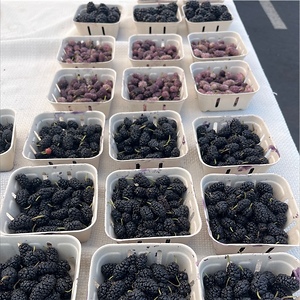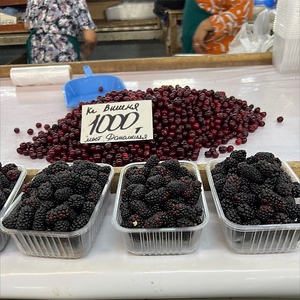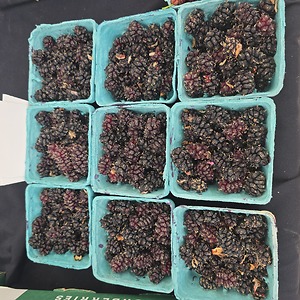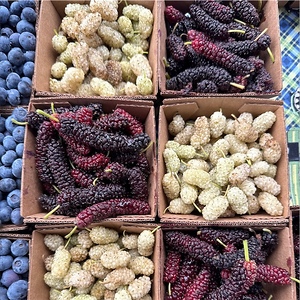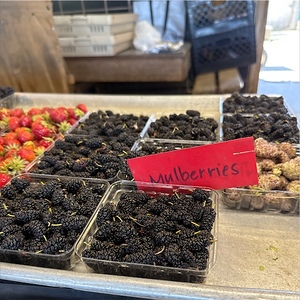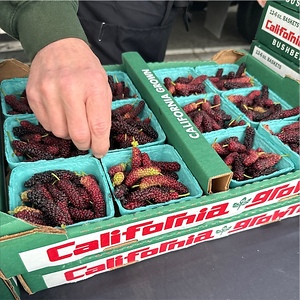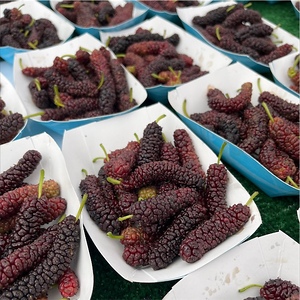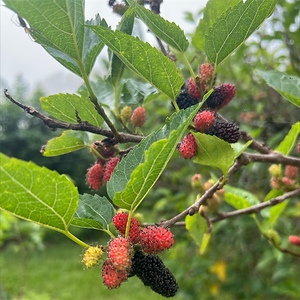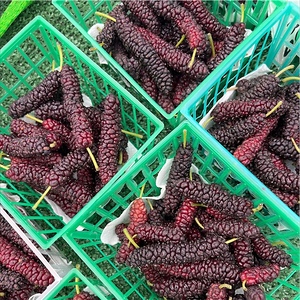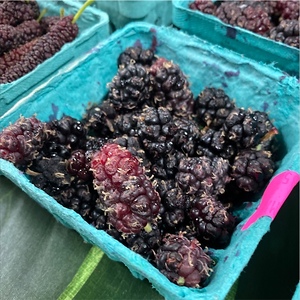


Mulberries
Estimated Inventory, 12 ct : 0
Description/Taste
Mulberries are elongated, berry-like fruits made up of tiny, densely packed drupes arranged around a central stem. They have a cylindrical shape, giving them the appearance of an elongated blackberry. Each of these individual fruits measures between about 2.5 to 4 centimeters long and can have a deep purple-black, red, pink, or white hue depending on the variety. Mulberries have a light green stem and a shiny, delicate texture with faint hairs between the drupes and soft, tiny seeds dispersed throughout the fruit. They are fragile to the touch, often releasing a syrupy juice that easily stains when squished. Mulberries are aromatic and possess a balance of sweet and tart flavors.
Seasons/Availability
Mulberries are available during the summer.
Current Facts
Mulberries belong to the Morus genus and encompass many different botanical names including Morus alba, Morus nigra, Morus rubra, and Morus macroura. All of these varieties belong to the Moraceae family which also includes figs, breadfruit, and jackfruit. Despite their name, Mulberries are not botanically classified as a berry. There are around 10 true Mulberry species, the four most popular being Red or American mulberries, White mulberries, Black mulberries, and Himalayan mulberries. These fruits emerge from trees that can grow anywhere from 9 to 24 meters tall and have leaves that serve as the only food silkworms eat. The production of silk was one of the main reasons behind the expanded cultivation of Mulberry trees. They also provide timber for sports equipment and furniture. Aside from the ornamental and practical values of their trees, Mulberry fruits provide culinary benefits as they are often used in preserves and baked goods.
Nutritional Value
Mulberries are a significant source of vitamin C, which strengthens the immune system, promotes skin health, and aids in collagen production. The presence of vitamin E in these fruits offers antioxidant protection, helping to defend cells against oxidative stress and support skin and eye health. Their vitamin K1 content plays a critical role in blood clotting and bone health. Additionally, Mulberries provide iron, which is essential for the production of hemoglobin, improving oxygen transport in the blood and preventing anemia. These fruits also contain potassium, a vital electrolyte that helps regulate blood pressure, supports proper nerve function, and aids in muscle contraction. Mulberries are rich in antioxidants, including anthocyanin, which is responsible for deep red or purple coloring in fruits and vegetables. Mulberries are also known for containing resveratrol, a plant compound that may possess anti-aging properties.
Applications
Mulberries can be enjoyed fresh, puréed, cooked, dried, preserved, or juiced. They are commonly used in desserts like ice cream, sorbet, pies, crumbles, muffins, and crostatas. These fruits also pair well with chocolate and can be incorporated into brownies. Mulberries may be tossed in savory dishes like salads, salsas, glazes, and sauces for duck, chicken, and pork. They can be served alongside meats, cheeses, nuts, and other fruits on a charcuterie board. Mulberries are frequently featured in jams and compotes. They do well in beverages like mojitos, green juices, smoothies, lemonades, iced teas, and mocktails. Dried Mulberries are often mixed into yogurt parfaits, fruit bars, trail mix, granola, and oatmeal. They can be substituted for blackberries, but are considerably sweeter and have a lower moisture content. Complimentary pairings include other bramble berries, stone fruits, pears, beets, young cheeses such as burrata and chevre, wild game, basil, mint, arugula, cream, mascarpone, and citrus. Their fibrous inner stems should be removed or thoroughly puréed to avoid any unwanted fragments. Mulberries may be stored in the refrigerator for 2 to 3 days.
Ethnic/Cultural Info
There are several references to Mulberries in the works of William Shakespeare. In the tragedy Coriolanus, he mentions the fragility and staining quality of ripe Mulberries, stating that the ripest Mulberry will not hold the handling. In A Midsummer Night’s Dream, lovers Pyramus and Thisby plan to meet at Ninus’ Tomb underneath a Mulberry tree. When Pyramus arrives, he finds a bloodstained scarf that belonged to Thisby. He soon after takes his own life, thus imparting a dark red hue onto the tree's white Mulberries.
Geography/History
Mulberries originated in China about 4,000 years ago during the Western Zhou Dynasty. They thrive in semi-arid, warm temperate, subtropical, and tropical climates with full sun exposure and well-drained soils. Mulberries may be foraged from the wild in Eastern and Central China but are mostly produced commercially or in home gardens. They were introduced to Europe through the Silk Road trade system and have been naturalized on the continent for centuries. Within Europe, the Romans brought these fruits to Britain when they invaded. Mulberries were introduced to America during early colonial times when General Oglethorpe imported 500 White mulberry trees to Fort Frederica in Georgia in 1733, hoping to encourage silk production in this English colony but failing to do so. Despite Mulberry trees being extremely fruitful, with some yielding a couple hundred pounds of fruit per year, the fruits' fragility and tendency to easily bruise and leak make them less commercially viable. They are most often found at farmers' markets or specialty grocery stores in China, the Eastern Mediterranean, Northern and East Africa, Madagascar, Afghanistan, Northern Pakistan, Latin America, Central America, the Caribbean, and throughout the United States, particularly in the South and on the East Coast.
Recipe Ideas
Recipes that include Mulberries. One



